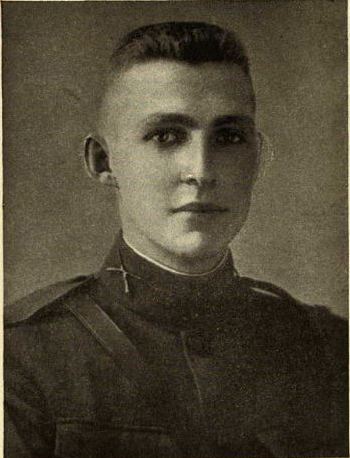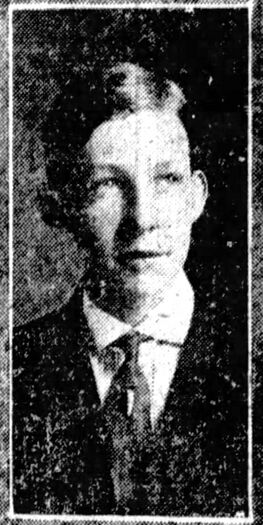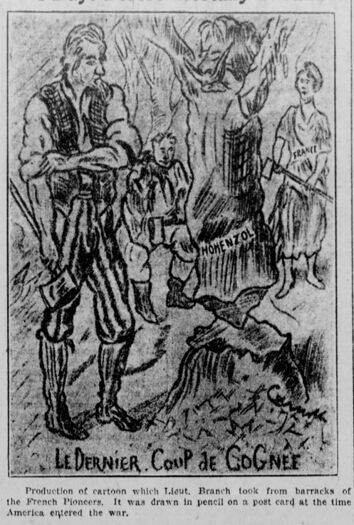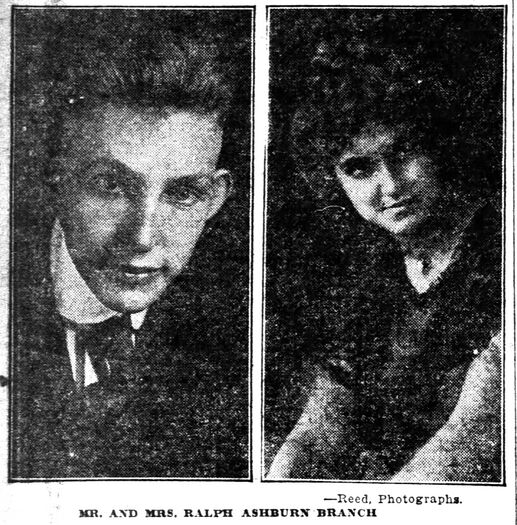RALPH A. BRANCH, 1LT, USA
Ralph Branch '16
Ralph Ashburn Branch was admitted to the Naval Academy from Kansas on July 20, 1912 at age 19 years 0 months.
He resigned on May 19, 1913.
Photographs
Loss
Ralph Ashburn Branch was lost on September 8, 1918 when he died of wounds received while fighting German forces on July 29, 1918. He was a member of M Co., 109th Infantry Regiment, which was on the Western Front at the time.
Other Information
From researcher Kathy Franz:
Ralph was born in Muncie, Indiana, and in 1900, his father Robert was a mine operator in Marion Township, Missouri. In 1905, Ralph lived in Wichita and was a carrier for the Wichita Beacon in 1910. He graduated from Wichita High School in 1911.
Ralph was nominated to the Naval Academy by Senator Joseph A. Bristow. His class work was of high quality, but he was discharged because his hearing in one ear became poor. He went into newspaper work for a while, and then attended Fairmount College (now Wichita State University.)
When on vacation from the college, he was a newspaper reporter for The Wichita Eagle. He was known around town as “Twig.” The newspaper on October 3, 1918, wrote: “Nothing would have seemed more improbable in those days than that this slender, studious, gentle, good-natured reporter should become a soldier, leading his men into one of the most heroic actions American troops have ever fought.”
Ralph graduated from Fairmount College in 1915 where he was known as “Lengthy.” He specialized in mathematics, was a member of Pi Alpha Pi Society, and was a reporter for the school newspaper, The Sunflower. He won a scholarship to Kansas University where he received a master’s degree in 1916. There, he was a member of Sigma Alpha Epsilon Fraternity. He spent most weekends in the fall or winter hunting rabbits or ducks. The Kansas University yearbook of 1919 published a memorial to him on page 17.
On June 22, 1916, Ralph saw a swimmer jump into a swift current from the Griffenstein bridge in Wichita. He walked fast along the river, and both he and the swimmer reached the Murdock avenue bridge in four minutes.
He married Mary Meyers on September 27, 1917, at the residence of Dr. Herring of the College Hill Congregational church. The marriage was kept secret until December 21 when Mary announced it at a house party.
As soon as his 19-year-old brother Robert heard of Ralph’s death, he said to sign him up. His registration in Wichita is dated September 12. He had been working for the National Cash Register Company in Dayton, Ohio. Their grandfather was Major Levi Ferguson.
Per The Wichita Beacon, October 2, 1918:
[Ralph] enlisted in Company A of the Wichita National Guards just before they were called and was made mess sergeant a short time afterwards. After the company went to Camp Doniphan, he was sent to Officers’ Training School and won his commission before he went to France.
At the Battle of Ourcq on July 29, 1918 . . .
This young man from Wichita led one of the charges. Early in the day a shell burst near him, hurling him about fifteen feet and wounding him. He went on. After a while he was wounded again but again he went on. A third time he was struck, but he never faltered. Finally two machine-gun bullets got him in quick succession. With five wounds in his body, he fell. He lay there several hours in that blasted desolation near the little French river . . .
Ralph survived a month in a French war hospital before the gangrene killed him. He had received a blood transfusion from Lieut. Kenneth Cassidy, also from Wichita. Cassidy wrote letters for Ralph while he was in the hospital.
From The Wellington Daily News, November 5, 1918:
The following letter was written and mailed by Lieutenant Ralph A. Branch on July 25, just 4 days before he was mortally wounded. The letter is one of the many interesting ones which was received by Mrs. Branch while her husband was in the service.
“The last night I was in Paris, I walked out to the bridge near the Champs Elysse and when I stepped out into the big plaza in the center of which stands the obelisk, the sun was just going down. A few smoky puffs of cloud hung in the southwest, and a few in the west. All were touched for a few minutes with a beautiful radiance, changing rapidly from a brilliant gold to a wonderful purplish pink, then fading altogether leaving them their former smoky gray. It was beautiful and the reflection in the river was as beautiful as the sky. All was hushed somehow, the traffic seemed something apart, as tho it realized its importance and did not try to bring discord into the air, while beauty reigned supreme.
“But with the passing of that magic radiance the city reasserted herself, and again the buzz of taxis and the infernal honking of their horns was borne in on the ear.
“All Paris is ecstatic just now because it is in co-operation with our men. The Sons of France are fighting as men never fought before. One can scarcely credit the newspaper accounts and yet they are all true. All France has her good word for the American Boys; all the world should be saying nice things about them. Anecdotes of the great battle stir you to tears, and again to blind rage. My only regret is that I, too, couldn’t take part. Maybe it isn’t too late yet.
“Above all else, everyone says the Americans are the grittiest lot in the world. No complaint unless he happened to ‘get his’ before he was able to lay ont a Boche, does Sammy ever make.”
“And do you know why we have the best army in the field? I can tell you one reason; we have the best army back of us. You people at home with your tender thoughts, your love; our mothers who brought us into this world and taught us how to live in it; our other ancestors farther back who fought hard battles and won, who lived long, clean lives, laid the foundation for the morale of this army which has done many unheard of and impossible things, and is destined to do more for them. For we have only begun to fight.”
A memorial service was held for Ralph on October 6 at the Central Church of Christ in Wichita where he had been a member. A gold star was placed on its service flag.
From Find A Grave:
Born at Muncie, Indiana, July 16, 1895. Graduated from Fairmount College 1915, and attended Kansas University 1916. Held commission of first Lieutenant. Died September, 1918, of wounds received in Argonne Battle.
He was survived by his parents and younger brother; Ralph is buried in the Saint Mihiel American Cemetery and Memorial, Lorraine, France. He also has a memory marker in Missouri.
Ralph is listed on the killed in action panel in front of Memorial Hall.
Photographs
Memorial Hall Error
Ralph was a 1LT; Memorial Hall has him as a 2LT.

The "category" links below lead to lists of related Honorees; use them to explore further the service and sacrifice of alumni in Memorial Hall.



